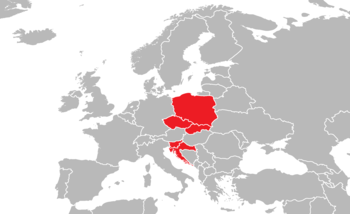Catholic Slavs
Catholic Slavs and Slavic Catholic are terms used for the historically and/or predominantly Catholic Slavic ethnic groups and nations and for the history of Catholicism among the Slavic peoples. The Catholic Slavic nations include all West Slavs (Poles, Czechs and Slovaks and all their sub-ethnicities ex. Kashubs, Silesians) as well as the westernmost South Slavs (Slovenes and Croats).[1]
 Catholic Slavic countries (Poland, Czech Republic, Slovakia, Slovenia and Croatia) | |
| Total population | |
|---|---|
| c. 60,500,000 (2018 est.) | |
| Regions with significant populations | |
| Central Europe and Southeastern Europe | |
| Languages | |
| West Slavic South Slavic | |
| Religion | |
| Catholic Church | |
| Related ethnic groups | |
| Other Slavs |
History
Middle Ages
Grand Duke Kazimierz IV of Lithuania and Poland (r. 1440–92) initiated the Catholicization of Kiev (which was Orthodox) early in his reign.[2]
Early modern period
The Union of Brest (1596) saw the official establishment of the Uniate Church (Eastern in custom and ritual but subscribing to Catholic dogma and submission to the Pope as head of the Church) in the Grand Duchy of Lithuania.[2]
The Habsburg Monarchy launched a programme of re-Catholicization in Bohemia and Moravia in the 1620s.[3] The Serbian Orthodox Eparchy of Marča became Uniate in 1611, although it was part of a conflict between local Catholic and Orthodox clergy over the century.[4]
Modern states
Modern countries in which historically Catholic Slavs formed a majority or otherwise such nation states include:
See also
- Slavic Christianity
- Orthodox Slavs
- Slavic Muslims
References
- Slavica Jakelic (23 May 2016). Collectivistic Religions: Religion, Choice, and Identity in Late Modernity. Routledge. pp. 101–. ISBN 978-1-317-16420-3.
- Cooper 2003, p. 227.
- Josef V. Polišenský (1971). The Thirty Years War. University of California Press. pp. 141–. ISBN 978-0-520-01868-6.
- Zlatko Kudelić (2007). Marčanska biskupija: Habsburgovci, pravoslavlje i crkvena unija u Hrvatsko-slavonskoj vojnoj krajini (1611. - 1755). Hrvatski Inst. za Povijest. ISBN 978-953-6324-62-0.
Sources
- Cooper, Henry R. (2003). Slavic Scriptures: The Formation of the Church Slavonic Version of the Holy Bible. Fairleigh Dickinson Univ Press. pp. 227–. ISBN 978-0-8386-3972-6.CS1 maint: ref=harv (link)